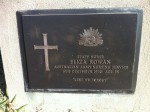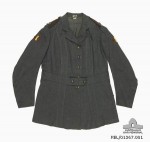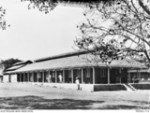ROWAN, Eliza
Eliza Rowan (1885-1970) was born at Nagambie in 1885 to Lee Rowan (1847-1899) and Margaret Jane Davies (1851-1931).
Both her parents had been born in the early days of colonial Melbourne. Lee's parents, a baker and a laundress, came from Armagh in Northern Ireland, arriving in Port Phillip on the 'China' in 1840 after a torrid six month voyage. Margaret came from Welsh stock. Their children were all born around Nagambie and Heathcote, and all but one lived into or beyond their seventies.
Birth records indicate Lee and Margaret Rowan and their expanding family lived in the Heathcote-Nagambie area of Victoria from the late 1860s. Lee was a farmer whose name appeared occasionally in the local papers, in connection with land rental licenses (29 acres in 1883, Kilmore Free Press, 8.11.1883) and financial and credit issues (e.g. Bendigo Advertiser, 10.6.1880). He died in 1899 aged 52 in Baillieston and was buried at Nagambie.
Lee and Margaret had at least nine children, three sons and six (possibly seven) daughters, who were born between 1869 and 1888. Eliza was born in 1885. In the decade after Lee's death, one adult daughter (Clara Jane) died and most of the other children scattered in search of employment. Alexander Lee and Clement worked as miners (the area around Baillieston had working gold, antinomy and quartz mines from the 1860s). Henrietta and Edith came to Melbourne and worked as dressmakers.
(Phoebe) Ella, Ida and their younger sister Eliza went to far off Western Australia. Ella married a bricklayer in Perth in 1901 and Ida married in Boulder on the gold fields in 1911. Only William appeared to stay in the vicinity of home, dying near Nagambie in 1953.
Eliza trained to be a nurse at the Perth Public Hospital (subsequently Royal Perth Hospital), completing the requirements for hospital registration in March 1914. Her registration with the Australian Trained Nurses Association is dated 1913, and with the Victorian Trained Nurses Association 1916. On coming to Melbourne, she presumably worked as a private nurse through the Winfield Nurses Home at 340 Albert St, East Melbourne.
War Service
Eliza Rowan applied to join the Australian Army Nursing Service (AANS) in June 1917.
She was one of three immediate family members to enlist. Alexander Lee Rowan, her oldest brother (1869-1943), had joined up and embarked with the 12th Battalion in mid 1916. Clement (1881-1956) joined the 2nd Tunnelling Company reinforcements in June 1917, the same month as Eliza enlisted.
All three named their younger sister Henrietta (1887-1968) as next of kin. Henrietta, dressmaker by profession, was living in rooms at Hotham House, 175 Hotham House, East Melbourne with her sister Edith (1888-1974), a white worker. Henrietta and Edith lived in East Melbourne for a number of years before, during and after the 1914-18 war, at 165 Gipps St, 175 Hotham St, and later at 19 and 25 Lansdowne St.
It is not beyond the realms of possibility that Henrietta and Edith made Eliza's uniform, items from which are in the Australian War Memorial (see below).
Eliza's application for the AANS is scant on detail, and has no reference to her nursing training or experience in either Perth or Melbourne. It gives her permanent address as 'Winfield Nurses Home', which at 340 Albert St, East Melbourne was just a short walk from where Henrietta and Eliza lived. She gave her religion as Baptist (Alexander gave Church of England and Clement Congregationalist).
Eliza embarked on active service from Melbourne on Royal Mail Steamer 'Somali' on 30 June 1917, one of 61 nurses from 3 Military District led by Emily Mills. They disembarked in Bombay a month later.
Eliza was immediately posted to the 500 bed Freeman Thomas Hospital, one of four British Hospitals in Bombay that received sick and wounded troops from the front in Mesopotamia and was staffed mainly by Australian nurses and British medical officers. It was a civic building converted into a hospital. Many of the patients suffered from heat stroke, malaria or dysentery. There is no written record of Eliza's experience there but another Victorian nurse wrote her colleagues 'liked it fairly well', adding 'some of the sisters are Eurasian but they are mostly nice women' (Lilydale Express, 21.6.1918).In her time off duty, Eliza and the other nurses undoubtedly explored the sights of Bombay and its surrounds - the Victoria Gardens, zoo, bazaars, Bandra Point and native villages.
In February 1918, Eliza was transferred to 44 British General Hospital in Deolali, and six months later to the nearby 34 Welsh General Hospital. A 170 kilometre, four hour train journey from Bombay, Deolali was a Hill station well above sea level, a long-time British military barracks with a garrison hospital. 44 BGH held 1,200 beds with 23 Australian nurses and 10 others; 34 WGH had 3,000 beds with 42 Australian nurses and 20 others. Another member of the AANS described it to her family in glowing terms: 'The railway service up is splendid. Deolali consists of a huge hospital remount station and garrison and a straggling native village. The climate is delightful' (Bessie Hooper, 34 WGH, Advertiser, 25.8.1917). Some patients were convalescents. Hooper described her patients at 34 WGH as all Turkish prisoners of war, surgical cases. She wrote warmly of them (they were 'so grateful and so clean and immaculate') and hinted at their terrible wounds ('you would say Gallipoli has been avenged'). Others including Matron Alma Bennett were much less enthusiastic about the conditions in the hospital itself (see Jan Bassett, Guns and Brooches: Australian Army Nursing from the Boer War to the Gulf War, 1992, p.76).
There was a very ugly side to 34 WGH immediately before and during Eliza Rowan's time there. Six unidentifiable Australian nurses had been accused of immoral activities with Turkish patients and British non-commissioned officers. Following a court of inquiry and even a voluntary medical examination of one of the accused, the nurses were exonerated. The matter, which was hushed up with the connivance of the Australian government, left the nurses with a very sour taste. (See Jan Bassett, Guns and Brooches: Australian Army Nursing from the Boer War to the Gulf War, 1992, pp.76-81; Ruth Rae, 'Reading between unwritten lines: Australian Army nurses in India, 1916-19, Journal of the Australian War Memorial, www.awm.gov.au/journal/j36/nurses.asp).
Eliza Rowan left Bombay for Australia on the 'City of Cairo' on 28 February 1919, and was discharged from the AANS on 8 October 1919.
As her war servicewas confined to India, she did not qualify for the Victory Medal.
After the War
For a decade after the war, at least until after 1931, Eliza's address on the Australian electoral rolls remained unchanged from her address in 1914, the nurses home/depot at 340 Albert St, East Melbourne. She completed midwifery training (not uncommon for returned nurses) at the Royal Sydney Hospital and took the Australian Trained Nurses Association obstetrics examination in 1920. She registered as a trained nurse in Western Australia, doubtless to work there for a time near her sisters Ella Flynn and Inda Hunter (a widow).
Her interest in military nursing continued well beyond her discharge in 1919. She was a member of the AANS Reserve in 1925.
Throughout her postwar life Rowan faced a number of difficulties which were documented in many applications for assistance to the Edith Cavell Trust Fund which provided support for sick and needy Victorian army nurses (Eliza Rowan, Application File, Edith Cavell Trust Fund, M290, NAA, Melbourne.) She made more than twenty applications between 1919 and 1959 and received assistance totalling £475.
Rowan had returned from India in 1919 medically unfit and she never regained full health. Influenza, depression, rheumatism and dental problems plagued her in the 1920s. She could nurse only intermittently but needed work so she had accommodation. Financial difficulties and the scarcity of suitable positions exacerbated her health problems, although in 1934 she had been working and living at Caulfield Repatriation Hospital for eighteen months. She had no repatriation pension. In 1950 Rowan, then caretaker of the ECTF’s holiday house at Dromana for nurses, applied again. With worsening health and despite the aged pension, she was unable to buy more than ‘bare necessities in food and some medicine’: comfortable shoes, firewood and new glasses were beyond her reach. The ECTF provided her with £35–40 a year throughout the 1950s. A note on her ECTF file in 1953 described her as being ‘in a sad plight’. Rowan’s last application was dated September 1958.
She died in Dromana on 6 December 1970, aged 85, and was buried in the Dromana Cemetery.
Janet Scarfe, Adjunct Research Associate, Monash
29 January 2017
Can you help?
Can you correct or provide more information about this person?
Or are you able to help with this history project?
- Family stories and records including photos, documents and memorabilia?
- Stories or information in books, newspapers and on-line?
- Memorial plaques in churches and public places?
- War memorial, church, national and state archives?
If so, please Contact the East Melbourne Historical Society.



